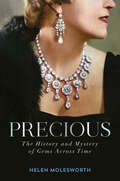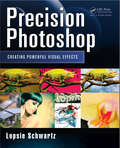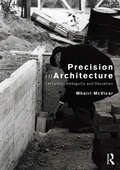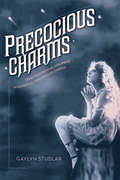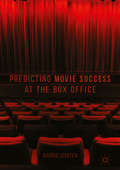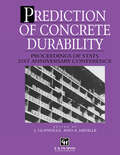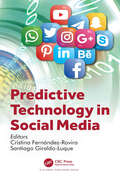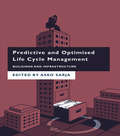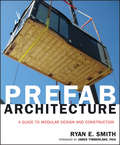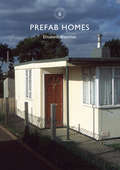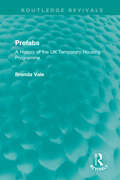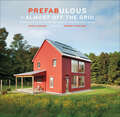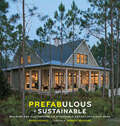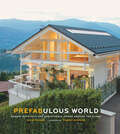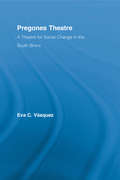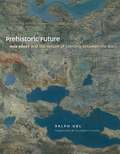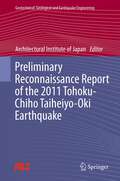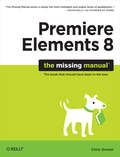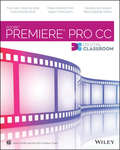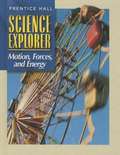- Table View
- List View
Precious: The History and Mystery of Gems Across Time
by Helen MolesworthA renowned jewelry expert recounts her career working with nature&’s most extraordinary treasures—gemstones—and traces these rare jewels from ancient Egyptian records through the high-stakes auctions of today.Helen Molesworth has been captivated by precious stones since early childhood but she struggled to join the gemstone industry, having no connections to the few family-run companies that have dominated the field for centuries. She persevered, and more than two decades later, Molesworth is now an international authority hired to appraise the extraordinary jewelry of such clients as the British royal family. Precious is packed with inside stories about fabulous jewels associated with generations of celebrities, from Cleopatra (emerald) to Catherine, Princess of Wales (sapphire); from Marilyn Monroe (pearl) to Beyoncé (garnet); from Jackie O (pearl) to Lady Gaga (diamond); and from Marie Antoinette (pearl) to Elizabeth Taylor (pearl, ruby, and emerald)! As Molesworth tells it, the history of gemstones is the history of humanity. And so she journeys the world, navigating African diamond mines, Colombian emerald mines, and the sapphire-rich rivers of Sri Lanka to study gems at their source. She has selected ten of nature&’s most dazzling gems, tracing their discovery to when these cut-and-polished masterpieces first adorned empresses and kings. From the stories of a priceless emerald watch hidden under floorboards for centuries to the common quartz fashioned into world-famous royal jewels, and diamonds selling for multi-millions, Precious is not just a chronicle of archeology and geology, high society and high finance, it&’s the story of our timeless ambition to make—and wear—something beautiful.
Precision Photoshop: Creating Powerful Visual Effects
by Lopsie SchwartzThe Essentials of Photoshop for Creative ProfessionalsThere are plenty of books on Photoshop for photographers; for everyone else, there's Precision Photoshop: Creating Powerful Visual Effects. In clear, conversational language using extensive images and screenshots, this book gives you in-depth guidance on learning how to use Photoshop. The author
Precision in Architecture: Certainty, Ambiguity and Deviation
by Mhairi McVicarThis book offers a detailed insight into the desire for, and consequences of, precise communications in the daily life of contemporary architectural practice through close readings of constructed architectural details by Sigurd Lewerentz, Caruso St John Architects, Mies van der Rohe and OMA. In the professionalised context of the contemporary architectural profession, precise communications – drawings, specifications, letters, faxes and emails – are charged with the complex task of translating architectural intent into a neutral and quantifiable language which is expected to guarantee an exact match between the architects’ intentions and the constructed result. Yet, as any architectural practitioner will know, it is doubtful whether the construction of any architectural project may ever exactly match all written and drawn predictions. This book challenges claims to certainty which have been attributed to such communications from the mid-nineteenth century onwards, and critiques ongoing expectations of certainty in contemporary architectural production.
Precocious Charms
by Gaylyn StudlarIn Precocious Charms, Gaylyn Studlar examines how Hollywood presented female stars as young girls or girls on the verge of becoming women. Child stars are part of this study but so too are adult actresses who created motion picture masquerades of youthfulness. Studlar details how Mary Pickford, Shirley Temple, Deanna Durbin, Elizabeth Taylor, Jennifer Jones, and Audrey Hepburn performed girlhood in their films. She charts the multifaceted processes that linked their juvenated star personas to a wide variety of cultural influences, ranging from Victorian sentimental art to New Look fashion, from nineteenth-century children's literature to post-World War II sexology, and from grand opera to 1930s radio comedy. By moving beyond the general category of "woman," Precocious Charms leads to a new understanding of the complex pleasures Hollywood created for its audience during the half century when film stars were a major influence on America's cultural imagination. how classic Hollywood cinema constructed gender and sexuality beyond the general category of "woman," leading to a new understanding of how Hollywood spoke to and created pleasures for its audiences from the 1910s into the 1960s.
Predator: A Memoir, a Movie, an Obsession
by Ander MonsonA searching memoir of a life lived in the flicker of an action film, by the author of I Will Take the Answer In his first memoir, Ander Monson guides readers through a scene-by-scene exploration of the 1987 film Predator, which he has watched 146 times. Some fighters might not have time to bleed, but Monson has the patience to consider their adventure, one frame at a time. He turns his obsession into a lens through which he poignantly examines his own life, formed by mainstream, white, male American culture. Between scenes, Monson delves deeply into his adolescence in Michigan’s Upper Peninsula and Riyadh, his role as a father and the loss of his own mother, and his friendships with men bound by the troubled camaraderie depicted in action and sci-fi blockbusters. Along with excursions into the conflicted pleasures of cosplay and first-person shooters, he imagines himself beside the poet and memoirist Paul Monette, who wrote the novelization of the movie while his partner was dying of AIDS.A sincere and playful book that lovingly dissects the film, Predator also offers questions and critiques of masculinity, fandom, and their interrelation with acts of mass violence. In a stirring reversal, one chapter exposes Monson through the Predator’s heat-seeking vision, asking him, “What do you know about the workings of the hidden world?” As Monson brings us into the brilliant depths of the film and its universe, the hunt begins.
Predicting Movie Success at the Box Office
by Barrie GunterThis book explores the different factors that can influence a new movie’s prospects at the box office. Looking at factors such as the production budget, distribution model, genre, stars and audience reactions of films, Gunter asks how such aspects may reduce the uncertainties of success so common in the movie industry. The reader is taken on a journey through filmmaking factors that, research suggests, impact box office performance. While box office revenues represent only part of a movie’s earning potential, Gunter highlights how theatrical performances remain central to what the movie business is about. The chapters illustrate how ticket sales are largely influenced by the production budget but also cultural differences and new movie platforms.
Predicting Outcomes of Investments in Maintenance and Repair of Federal Facilities
by Committee on Predicting Outcomes of Investments in Maintenance Repair for Federal Facilities"Challenging. . . The real value of this book is in Mr. Hacker's calm, analytical eye, his unblinking view of American history and his unwillingness to accept cant and 'common sense' as facts. " --Tom Wicker The New York Times Book Review Why does race remain America's deepest and most enduring division? Despite all efforts to increase understanding and expand opportunities, black and white Americans still lead separate lives, continually marked by tension and hostility. In his bestselling analysis of a divided society, Andrew Hacker explains why racial disparities persist. He clarifies the meaning of racism, conflicting theories of superiority and equality, as well as such subtle factors as guilt and sexual fears. Using completely updated statistical data to paint the stark picture of racial inequality, Two Nations depicts the realities of family life, of income and employment, as well as current controversies affecting education, politics, and crime, including the role of race in the Simpson trial. This startling look at the facts that so many choose to ignore is balanced by the voices of African Americans, and shows how race influences the attitudes and behavior of all Americans. Reasoned, accurate, and devastating, Two Nations demonstrates, better than emotional appeals can, how this great and dividing issue has defined America's history and, as Hacker forecasts it, will play a pivotal role in the coming century. "Provocatively enlightening. . . Probably the most candid book on present day American racism to be written in the 20th century. " --Claude Brown Author of Manchild in the Promised Land "A telling portrait of American life. . . of the very different ways the two races live. . . The numbers are stark and irrefutable. " --The Wall Street Journal EXPANDED AND UPDATED EDITION -- Including a new chapter on the O. J. trial
Prediction of Concrete Durability: Proceedings of STATS 21st anniversary conference
by J. Glanville A. NevillePoor durability of concrete is a continuing concern to owners of structures and their professional advisors. Advances in methods of assessing and predicting durability are being made in many areas, and this book provides a state of art review of the current situation. Contributions from leading researchers and consultants make it a valuable guide f
Predictive Technology in Social Media
by Cristina Fernández-RoviraCan behaviour on social media predict future purchase patterns? Can what we click on social media foresee which political party will we vote for? Can the information we share on our wall foretell the next series I might want to watch? Can the likes on Instagram and Facebook predict the time one will spend on digital platforms in the next hour? The answer is no longer science fiction. It points to the ability of mainstream social media platforms such as Facebook and Twitter to be able to deliver specialised advertising services to highly targeted audience segments controlled by the billions of devices that flood our daily lives. At the same time, it highlights a more relevant problem: can social media guide, suggest or impose a certain behaviour or thought? Everything seems to indicate that they can do it.Predictive Technology in Social Media comprises 10 essays that reflect on the power of the predictive technology of social media in culture, entertainment, marketing, economics and politics. It shows, from a humanistic and critical perspective, the predictive possibilities of social media platforms, as well as the risks this entails for cultural plurality, everyday consumption, the monopolistic concentration of the economy and attention, and democracy. The text is an invitation to think, as citizens, about the unbridled power we have ceded to digital platforms. A new voice to warn about the greatest concentration of communicative power ever seen in the history of humanity.
Predictive and Optimised Life Cycle Management: Buildings and Infrastructure
by Asko SarjaPredictive and Optimised Life-Cycle Management sets out methodologies to meet the demands of the current trend towards sustainable civil engineering and building. Encompassing all aspects of construction practice, from design through to demolition and the recycling of materials, Sarja provides tools for optimal property-value protection, including a description of an integrated and predictive Life-Cycle Maintenance and Management Planning System (LMS), which employs a wide range of techniques. Clear and practical, this guide provides effective methodology required to change a reactive system of management to a predictive one, which will benefit practitioners and students involved in construction, from the architect to local and government authorities; from design engineers to facility managers.
Prefab Architecture
by Ryan E. Smith"Prefab Architecture . . . is beyond theory, and beyond most of what we think we know about pods, containers, mods, and joints. This book is more than 'Prefabrication 101. ' It is the Joy of Cooking writ large for the architecture and construction industries. " --From the Foreword by James Timberlake, FAIA The definitive reference on prefab architecture for architects and construction professionals Written for architects and related design and construction professionals, Prefab Architecture is a guide to off-site construction, presenting the opportunities and challenges associated with designing and building with components, panels, and modules. It presents the drawbacks of building in situ (on-site) and demonstrates why prefabrication is the smarter choice for better integration of products and processes, more efficient delivery, and realizing more value in project life cycles. In addition, Prefab Architecture provides: A selected history of prefabrication from the Industrial Revolution to current computer numerical control, and a theory of production from integrated processes to lean manufacturing Coverage on the tradeoffs of off-site fabrication including scope, schedule, and cost with the associated principles of labor, risk, and quality Up-to-date products featuring examples of prefabricated structure, enclosure, service, and interior building systems Documentation on the constraints and execution of manufacturing, factory production, transportation, and assembly Dozens of recent examples of prefab projects by contemporary architects and fabricators including KieranTimberlake, SHoP Architects, Office dA, Michelle Kaufmann, and many others In Prefab Architecture, the fresh approaches toward creating buildings that accurately convey mature and expanded green building methodologies make this book an important voice for adopting change in a construction industry entrenched in traditions of the past.
Prefab Homes
by Elisabeth BlanchetIn 1944, Winston Churchill promised to manufacture up to 500,000 prefabricated bungalows to ease the housing shortage after the Second World War. Made in factories, over 156,000 temporary "prefabs" of a few designs were delivered to eager Local Authorities. They were nicknamed 'Palaces for the People'. With convenient kitchens, bathrooms and heating systems, they proved popular. Intended to be demolished before 1959, prefabs were defended by residents who campaigned to keep their family homes and communities. Nearly seventy years later, the last of these two bedroom homes are being demolished. Elisabeth Blanchet tells us the history of these popular homes with gardens, shows their different designs, and providesa glimpse indoors. Through the stories and memories of residents, she reveals the communities who were pleased to live in the prefabs, many of whom have for years been fighting local authorities' efforts to demolish them.
Prefab Houses DesignSource
by Marta SerratsFor many, the idea of prefab housing may bring to mind trailers and other less desirable images of home life. But this idea couldn't be more wrong! Rather, the newest trends in prefab have emerged as a great way for a design- (and cost-) conscious generation to achieve the dream of home ownership. Today, prefab houses are manufactured to the highest standards of construction and aesthetics. And with the internet, these houses can be ordered from all over the world--affording people everywhere the opportunity to acquire an affordable home of distinction.Prefab Modern explores the best prefabricated houses on the market today, from all over the world along with a resource directory on how you can purchase them. Included are case studies from all over the US and around the world, from top architects and designers.Prefab is the inevitable next step to "cool" housing as the market looks for reasonably priced housing for first and second homes. Prefab Houses Designsource is the perfect guide to this undeniable and fascinating trend.
Prefabs: A History of the UK Temporary Housing Programme (Routledge Revivals)
by Brenda ValeOriginally published in 1995, this book unravels the history of the ‘temporary bungalow’ and shows that perhaps it was more a question of providing a new peace-time product for factories than a means of providing accommodation for the homeless. Built in a period of housing history which remains fascinating for architects and planners and admired by some of their first occupants but berated by others, those prefabs remaining today are subject to preservation orders but also perhaps offer a solution to the ongoing housing crisis in the UK. The book includes chapters on the development of the prefab house in the UK; comparisons with temporary housing programmes in the USA, Sweden and Germany; political and economic considerations to the UK Temporary Housing Programme and a discussion of the design of the Arcon, Uni-Seco, Tarran and Aluminium Temporary Bungalows.
Prefabulous + Almost Off the Grid: Your Path to Building an Energy-Independent Home
by Sheri KoonesA beautiful, user-friendly overview to building more energy-efficient and environmentally friendly homes using prefabrication.Prefabulous + Almost Off the Grid explores the many ways of using prefabrication to build beautiful homes that are not only environmentally friendly, but also incredibly energy efficient. Profiling more than thirty of the most energy-efficient homes in the United States, this user-friendly guide reveals how homebuilders can achieve similar results—whether they want to earn an advanced green certification or just incorporate a few energy-saving measures—with the help of floor plans, detailed resource lists, explanations of the latest technologies, and brilliant photographs.Author Sheri Koones shows that building green doesn’t have to be more expensive, and in fact, can lead to dramatic savings. Koones’s almost-off-the-grid homes, which take energy from the grid when necessary and return any excess energy produced, are healthier, quieter inside, and far cheaper to operate. As energy costs continue to rise, energy independence is becoming increasingly essential, and as this guide shows, the almost-off-the-grid home is a solution that is achievable for everyone.Recipient of the 2013 Robert Bruss Gold Book Award from the National Association of Real Estate Editors (NAREE)Praise for Prefabulous + Almost Off the Grid“The time has come to throw out the old stereotypes and to embrace prefab building techniques as the way of the future?and the best approach for today. For anyone wanting to create a house that’s sustainable in every sense of the word, this book is an excellent place to start.” —Sarah Susanka, architect and author of The Not So Big House series“You can build a high quality, environmentally friendly and efficient home at a reasonable price with a look and feel of a traditional home. Advancements like those used in our house and the other houses in this book will transform the homebuilding industry.” —Christine Todd Whitman, former governor of New Jersey and administrator of the Environmental Protection Agency“This is an easy-on-the-eyes guide that includes floor plans and multiple images of the exterior and interior of each home. It is not a manual for green construction, but a general overview of aspects of prefab and green construction. And it does that well.” —Natural Life magazine
Prefabulous + Sustainable: Building and Customizing an Affordable, Energy-Efficient Home
by Sheri KoonesA guide to how prefabrication can assist those looking to build an energy-efficient home that won’t break the bank.Prefabulous and Sustainable dispels the negative myths associated with prefab homes and shows the reader how beautiful and remarkably green these homes can be. In this unique, hands-on guide for homebuilders, author Sheri Koones showcases twenty-five examples of how factory-built homes can be greener, more efficient, sturdier, and even more cost-effective than site-built homes. This practical manual gives you all the tools needed to customize a sustainable, prefab home at an affordable price. Koones outlines the materials, strategies, and systems used to create a sustainable living environment. Stunning photography and user-friendly floor plans and resource guides prove that green living is not as complicated as one might think—and is attainable for everyone.Praise for Prefabulous + Sustainable “Authoritative and beautiful. Once again, Koones builds her case for pre-fab thoroughly, and presents it in a compelling, well-organized package.” —Allen Norwood, NAREE Book Competition Head Judge“[Prefabulous + Sustainable] will soon become required reading for anyone interested in quality housing for the twenty-first century.” —Bob Berkebile, Fellow of the American Institute of Architects
Prefabulous World: Energy-Efficient and Sustainable Homes Around the Globe
by Sheri KoonesA stunning look at how people around the world are using prefabrication to create energy-efficient, sustainable, and stylish homes.Prefabulous World is the fourth book in Sheri Konnes’s revolutionary Prefabulous series. Presenting an international look at sustainable home design, it explores a compelling range of design styles and cutting-edge green technologies. The rising cost of fuel and the growing commitment to protect the environment have sparked exciting innovations in prefab home construction around the world. Showcasing many of the unlimited possibilities offered by prefabrication to build increasingly energy-efficient homes, Prefabulous World features fifty sophisticated examples of eco-friendly home design in Australia, New Zealand;Japan, Canada, the United States, England, Germany, South Africa, and beyond.“As we look into the future, it is clear the more and more intelligent materials and energies will be brought to hand as preassembled optimized components and systems, and they will be beautiful—just witness the homes we enjoy discovering in this lovely book.” —William McDonough, designer, advisor, thought leader, and co-author of Cradle to Cradle and The Upcycle
Pregones Theatre: A Theatre for Social Change in the South Bronx (Latino Communities: Emerging Voices - Political, Social, Cultural and Legal Issues)
by Eva Cristina VásquezFirst published in 2004. Routledge is an imprint of Taylor & Francis, an informa company.
Prehistoric Future: Max Ernst and the Return of Painting Between the Wars
by Ralph Ubl translated by Elizabeth TuckerOne of the most admired artists of the twentieth century, Max Ernst was a proponent of Dada and founder of surrealism, known for his strange, evocative paintings and drawings. In Prehistoric Future, Ralph Ubl approaches Ernst like no one else has, using theories of the unconscious--surrealist automatism, Freudian psychoanalysis, the concept of history as trauma--to examine how Ernst's construction of collage departs from other modern artists. Ubl shows that while Picasso, Braque, and Man Ray used scissors and glue to create collages, Ernst employed techniques he himself had forged--rubbing and scraping to bring images forth onto a sheet of paper or canvas to simulate how a screen image or memory comes into the mind's view. In addition, Ernst scoured the past for obsolete scientific illustrations and odd advertisements to illustrate the rapidity with which time passes and to simulate the apprehension generated when rapid flows of knowledge turn living culture into artifact. Ultimately, Ubl reveals, Ernst was interested in the construction and phenomenology of both collective and individual modern history and memory. Shedding new light on Ernst's working methods and the reasons that his pieces continue to imprint themselves in viewers' memories, Prehistoric Future is an innovative work of critical writing on a key figure of surrealism.
Prehistoric Rock Art
by Paul G. BahnPaul G. Bahn provides a richly illustrated overview of prehistoric rock art and cave art from around the world. Summarizing the recent advances in our understanding of this extraordinary visual record, he discusses new discoveries, new approaches to recording and interpretation, and current problems in conservation. Bahn focuses in particular on current issues in the interpretation of rock art, notably the 'shamanic' interpretation that has been influential in recent years and that he refutes. This book is based on the Rhind Lectures that the author delivered for the Society of Antiquaries of Scotland in 2006.
Preliminary Reconnaissance Report of the 2011 Tohoku-Chiho Taiheiyo-Oki Earthquake
by Architectural Institute of JapanDevastating damage in the Tohoku region of Japan occurred during and after the earthquake off the Pacific coast of Tohoku earthquake on March 11, 2011. The AIJ (Architectural Institute of Japan) dispatched reconnaissance teams into the field to obtain basic facts on the damage to buildings due to the massive ground motions and resultant tsunami. Their mission included collecting information on the characteristics of the earthquake itself and the observed major ground motions and tsunamis throughout the area. For the structural damage investigation, buildings are classified by their type of construction, namely, steel buildings, reinforced concrete buildings, wooden houses, etc. along with descriptions of special features for each category of building type. The report summarizes damage associated with ground failures including landslide and liquefaction as well as non-structural damages such as to equipment and facilities, partitioning walls and ceilings, and functional failures in skyscrapers. Also brief description of the Japanese Seismic Design Code will be provided in the Appendix. A proposed scheme of anti-tsunami design for buildings is also included.
Premiere Elements 8: The Missing Manual (Missing Manual)
by Chris GroverWhether you're aiming for YouTube videos or Hollywood-style epics, you need what Premiere Elements can't provide: crystal-clear guidance and real world know-how. This Missing Manual delivers. Packed with great ideas on how to spiff up your footage, this book helps you avoid the dreaded Help! I Never Do Anything With My Video syndrome. With this book, you'll learn how to use Premiere's two approaches to filmmaking: The quick-and-easy InstantMovie technique, and the classic, handcrafted approach for frame-by-frame editing with fine-tuned transitions, effects, and more. Premiere expert Chris Grover combines a touch of humor with insights, tips, and tricks culled from years of moviemaking experience to help you release your inner Scorsese. Create movies from start to finish with hands-on, step-by-step instructions Use InstantMovie to whip up a video ready for prime time Learn frame-by-frame editing to handcraft your story like the pros do Share your movie by saving it to disc, uploading it, or emailing it Add video effects that dazzle Use keyframes to precisely control cuts, special effects, and sound Tap Premiere's automated tools to analyze, organize, and rate your clips
Premiere Pro CC Digital Classroom (Digital Classroom)
by Jerron Smith AGI Creative TeamA Complete Training Package! Full-color, step-by-step instructional bookVideo training from expert instructorsTutorials and lesson files on companion DVD You have a personal tutor in the Digital Classroom If you want expert instruction that fits into your schedule, the Digital Classroom series delivers. Expert instructors guide you through each lesson, helping you learn essential Premiere Pro CC skills at your own speed. Full-color, step-by-step instructions in the book are enhanced with video tutorials on the companion DVD. With this Digital Classroom training package, you have your own private instructor showing you the easiest way to learn Premiere Pro CC. Import video, audio, and still images and edit them together on the Timeline Add transitions and effects to your video to make your projects more engaging and appealing Automatically stabilize shaky footage with the Warp Stabilizer Animate layered Photoshop files to create onscreen graphics Create text and titles using the built-in Premiere Pro Titler Use Adobe Encore to author your projects to disk or for web distribution DVD and other supplementary materials are not included as part of the e-book file, but are available for download after purchase.
Premiere Pro CS6 Digital Classroom (Digital Classroom)
by Jerron Smith AGI Creative TeamYou have a personal tutor in the Digital Classroom If you want expert instruction that fits into your schedule, the Digital Classroom series delivers. Expert instructors guide you through 11 lessons, helping you learn essential Premiere Pro CS6 skills at your own speed. Full-color, step-by-step instructions in the book are enhanced with video tutorials at the companion Web site digitalclassroombooks.com. With this Digital Classroom training package, you have your own private instructor showing you the easiest way to learn Premiere Pro CS6. Import video, audio, and still images and edit them together on the Timeline Add transitions and effects to your video to make your projects more engaging and appealing Automatically stabilize shaky footage with the Warp Stabilizer Animate layered Photoshop files to create onscreen graphics Create text and titles using the built-in Premiere Pro Titler Use Adobe Encore to author your projects to disk or for web distribution Note: Video tutorials and other supplementary materials are not included as part of the e-book file, but are available for download after purchase. Instructions are located in the "Starting Up" section.
